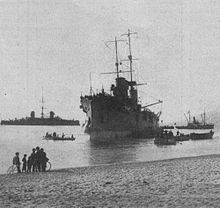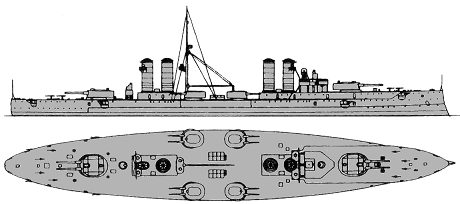Name San Giorgio Ordered 3 August 1904 Completed 1 July 1910 Construction started 4 July 1905 Length 141 m Draft 7.35 m | Laid down 4 July 1905 Struck 18 October 1946 Launched 27 July 1908 Weight 10,170 tons | |
 | ||
Builder Regio Cantiere di Castellammare di Stabia | ||
The Italian cruiser San Giorgio was the name ship of her class of two armored cruisers built for the Royal Italian Navy (Regia Marina) in the first decade of the 20th century. Commissioned in 1910, the ship was badly damaged when she ran aground before the start of the Italo-Turkish War in 1911, although she was repaired before its end. During World War I, San Giorgio's activities were limited by the threat of Austro-Hungarian submarines, although the ship did participate in the bombardment of Durazzo, Albania, in late 1918.
Contents

She acted as a royal yacht for Crown Prince Umberto's 1924 tour of South America and then deployed to the Indian Ocean to support operations in Italian Somaliland in 1925–26. San Giorgio served as a training ship from 1930 to 1935 and was then rebuilt in 1937–38 to better serve in that role. As part of her reconstruction, she received a modern anti-aircraft suite that was augmented before she was transferred to bolster the defences of Tobruk shortly before Italy declared war on the Allies in mid-1940. San Giorgio was forced to scuttle herself in early 1941 as the Allies moved in to occupy the port. Her wreck was used as an immobile repair ship by the British from 1943 through 1945. Salvaged in 1952, she sank while under tow to Italy to be broken up.
Design and description

The ships of the San Giorgio class were designed as improved versions of the Pisa-class design. San Giorgio had a length between perpendiculars of 131.04 metres (429 ft 11 in) and an overall length of 140.89 metres (462 ft 3 in). She had a beam of 21.03 metres (69 ft 0 in) and a draught of 7.35 metres (24 ft 1 in). The ship displaced 10,167 tonnes (10,006 long tons) at normal load, and 11,300 tonnes (11,100 long tons) at deep load. Her complement was 32 officers and 666 to 673 enlisted men.

The ship was powered by a pair of vertical triple-expansion steam engines, each driving one propeller shaft using steam supplied by 14 mixed-firing Blechynden boilers. Designed for a maximum output of 23,000 shaft horsepower (17,000 kW) and a speed of 22.5 knots (41.7 km/h; 25.9 mph), San Giorgio handily exceeded this, reaching a speed of 23.2 knots (43.0 km/h; 26.7 mph) during her sea trials from 19,595 ihp (14,612 kW). The ship had a cruising range of 6,270 nautical miles (11,610 km; 7,220 mi) at a speed of 10 knots (19 km/h; 12 mph).
The main armament of the San Giorgio-class ships consisted of four Cannone da 254/45 A Modello 1908 guns in twin-gun turrets fore and aft of the superstructure. The ships mounted eight Cannone da 190/45 A Modello 1908 in four twin-gun turrets, two in each side amidships, as their secondary armament. For defense against torpedo boats, they carried 18 quick-firing (QF) 40-caliber 76 mm (3.0 in) guns. Eight of these were mounted in embrasures in the sides of the hull and the rest in the superstructure. The ships were also fitted with a pair of 40-caliber QF 47 mm (1.9 in) guns. The San Giorgios were also equipped with three submerged 450 mm (17.7 in) torpedo tubes. During World War I, eight of the 76 mm guns were replaced by six 76 mm anti-aircraft (AA) guns and one torpedo tube was removed.
The ships were protected by an armoured belt that was 200 mm (7.9 in) thick amidships and reduced to 80 mm (3.1 in) at the bow and stern. The armoured deck was 50 mm (2.0 in) thick and the conning tower armour was 254 mm thick. The 254 mm gun turrets were protected by 200 mm of armour while the 190 mm turrets had 160 mm (6.3 in).
Construction and career
San Giorgio, named after Saint George, the patron saint of Genoa, was ordered on 3 August 1904 and laid down on 2 January 1907 at the Regio Cantieri di Castellammare di Stabia in Castellammare di Stabia. The ship was launched on 27 July 1908 and completed on 1 July 1910. San Giorgio ran aground on a reef off Naples-Posillipo on 12 August 1910, and was badly damaged. An estimated 4,369 tonnes (4,300 long tons) of water flooded the boiler rooms, magazines and lower compartments. To refloat the ship, her guns and turrets, together with her conning tower and some of her armour had to be removed.
San Giorgio was under repair at the outbreak of the Italo-Turkish War in September and only rejoined the fleet in June 1912. In February 1913, the ship cruised the Aegean Sea and made a port visit to Salonica, Greece, the next month. The ship ran aground again in November in the Strait of Messina, but she was only lightly damaged. The captain was dismissed as a result of the incident.
San Giorgio was based at Brindisi when Italy declared war on the Central Powers on 23 May 1915. That night, the Austro-Hungarian Navy bombarded the Italian coast in an attempt to disrupt the Italian mobilization. Of the many targets, Ancona was hardest hit, with disruptions to the town's gas, electric, and telephone service; the city's stockpiles of coal and oil were left in flames. All of the Austrian ships safely returned to port, putting pressure on the Regia Marina to stop the attacks. When the Austrians resumed bombardments on the Italian coast in mid-June, Admiral Paolo Thaon di Revel responded by sending San Giorgio and the other armored cruisers at Brindisi—the navy's newest—to Venice to supplement the older ships already there. Shortly after their arrival at Venice, Amalfi was sunk by a submarine on 7 July and her loss severely restricted the activities of the other ships based at Venice. San Giorgio participated in the bombardment of Durazzo on 2 October 1918 which sank one merchantman and damaged two others.
San Giorgio was relieved by the scout cruiser Brindisi as flagship of the Eastern Squadron on 16 July 1921 at Istanbul, Turkey. She later served in the Far East and China. In 1924 she conducted Crown Prince Umberto on his tour of South America. The ship departed Naples on 1 July and the outbreak of the second Tenente revolt in Brazil the following day forced the ships to divert to Argentina, where they arrived at Buenos Aires on 6 August. Three days later the government hosted a military parade in his honor which included a detachment of sailors from San Giorgio. He visited Chile before departing Montevideo, Uruguay on 5 September, bound for Bahia, Brazil. The ship sailed for home on 18 September.
After her return, she was assigned to the Red Sea and Indian Ocean Naval Division (Divisione Navale del Mar Rosso e dell'Oceano Indiano) in 1925–26, supporting operations in Italian Somaliland. From 1930 to 1935, the ship was based in Pola as a training ship for naval cadets and was sent to Spain after the Spanish Civil War began in 1936 to protect Italian interests. In 1937–38 she was reconstructed to serve as a dedicated training ship for naval cadets at the Arsenale di La Spezia: six boilers were removed and the remaining eight were converted to burn fuel oil which reduced her speed to 16–17 knots (30–31 km/h; 18–20 mph). Each pair of funnels was trunked together and her 76/40 guns were replaced by eight 100 mm (4 in) / 47 caliber guns in four twin turrets abreast the funnels. Her torpedo tubes were also removed while she received a light AA suite for the first time with the addition of six 54-caliber Breda 37 mm (1.5 in) guns in single mounts, a dozen 20 mm (0.79 in) Breda Model 35 autocannon in six twin mounts and four 13.2 mm (0.52 in) Breda Model 31 machine guns in two twin mounts.
Prior to her being sent to reinforce the defences of Tobruk in early May 1940, a fifth 100/47 gun turret was added on the forecastle and five more twin 13.2 mm machine gun mounts were added to better suit her new role as a floating battery. Two days after Italy declared war on Britain on 10 June, the British launched a co-ordinated sea and land attack against Tobruk. The British naval force, including the light cruisers Gloucester and Liverpool bombarded the port and engaged San Giorgio, which suffered no damage, while Royal Air Force Blenheim bombers from No. 45, No. 55, and No. 211 Squadrons also attacked Tobruk, striking San Giorgio with a bomb. On 19 June, the British submarine HMS Parthian fired two torpedoes at San Giorgio, but they detonated before hitting the ship. Her principal role was to supplement the anti-aircraft defences of Tobruk although she fired on Australian forces attacking Tobruk on 21 January 1941. As British and Australian troops were entering Tobruk, San Giorgio was scuttled in shallow water on the morning of 22 January by placing demolition charges in her magazines. The ship was awarded the Gold Medal of Military Valor (Medaglia d'Oro al Valor Militare) for her actions in the defence of Tobruk.
San Giorgio's hulk was commissioned by the British in March 1943 as HMS San Giorgio for use as a repair ship and was used by them for the rest of the war. The wreck was refloated in 1952, but it sank en route to Italy.
